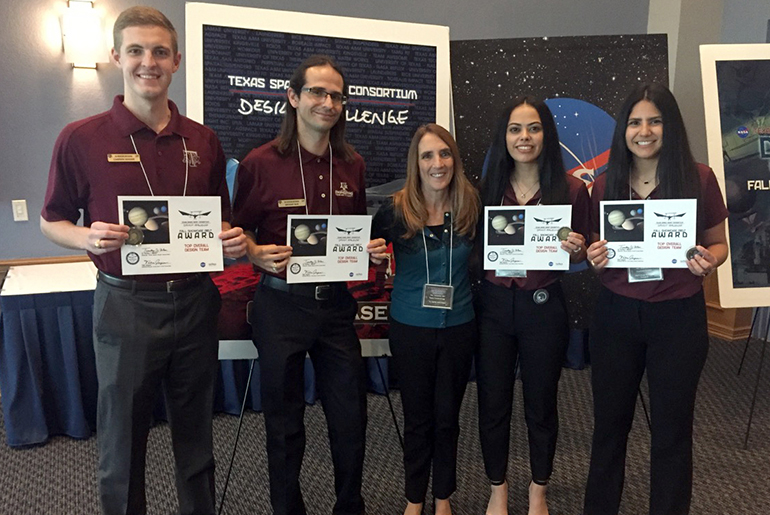
A senior design course capstone team in the Department of Industrial and Systems Engineering at Texas A&M University won first place in the Texas Space Grant Consortium (TSGC) Design Challenge for their presentation on 3D printed antennas.
The TSGC Design Challenge is a unique academic experience offering undergraduate students an opportunity to propose, design and fabricate a solution to a toward solving research objectives of importance to NASA and its mission.
The team, ISEN TEAM 10 NASA, won first place in top design, second in best poster and best model, and third in best oral presentation at the event.
Team members included undergraduate students Gregory Bair, Cindy Zuniga, Stephanie Urrutia and Cameron Wagner. Dr. Nancy Currie-Gregg, professor of practice in the Department of Industrial and Systems Engineering and former astronaut, was the team’s faculty advisor.
“As space exploration deepens, resupply missions are become more and more complex making 3D printing a preferred solution,” said Urrutia. “If a part breaks or is missing, a 3D printer could print a part in a matter of hours rather than having to wait weeks or months for a resupply mission.”
The challenge tasked competitors with evaluating the performance of commercially available 3D conductive filaments in antenna applications.
“With recent advances in 3D printing methods, a wide variety of new filaments have been developed including conductive filaments,” said Urrutia. “We selected two PLA filaments; Graphite PLA by Proto-pasta and F-Electric by Functionalize. We then made a model of a horn antenna using solidworks and printed it at the Engineering Innovation Center.”
With the help of the Department of Electrical and Computer Engineering, the team conducted an impedance and radiation pattern test. While the antennas were not conductive enough to perform as antennas, the team learned valuable information from the experience.
“As an industrial engineer, I only had a basic understanding of electrical engineering concepts and 3D printing,” said Urrutia. “I spoke to subject matter experts and brought their knowledge together to complete the project. This was the first time I had the opportunity to work with a multidisciplinary team, and I thoroughly enjoyed it.”
Currie-Gregg enjoyed mentoring the students and was proud of the manner in which they represented the department, college and university.
“The students were extremely enthusiastic and learned a tremendous amount throughout the semester including technical skills such as CAD design and additive manufacturing, project management skills, and the importance of collaboration with other engineering disciplines,” said Currie-Gregg.